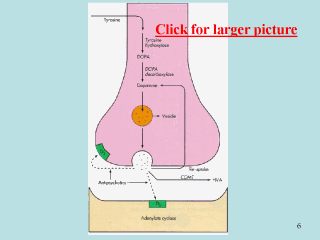| front |1 |2 |3 |4 |5 |6 |7 |8 |9 |10 |11 |12 |13 |14 |15 |16 |17 |18 |19 |20 |21 |22 |review |
 |
Daily treatment
with neuroleptics for several weeks produces a reversible cessation of firing of midbrain
DA neurons. These inactivated neurons are said to be in a state of “depolarization
block” and can be induced to fire again by local application of inhibitory
transmitters such as GABA. The molecular mechanism underlying production of depolarization
block of midbrain DA neurons is unknown, but the block is presently the most cohesive
explanation of antipsychotic action. Another delayed effect seen with chronic administration of antipsychotic drugs is proliferation of DA receptors, detectable as an increase in haloperidol binding (Seeman 1987), and also a pharmacological supersensitivity to DA, somewhat akin to the phenomenon of denervation supersensitivity. Fig. 10. Sites of action of many antypsychotic drugs. |